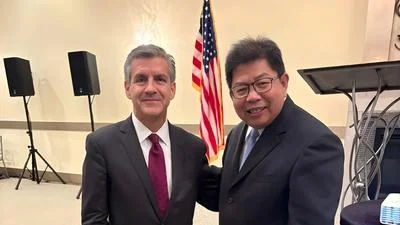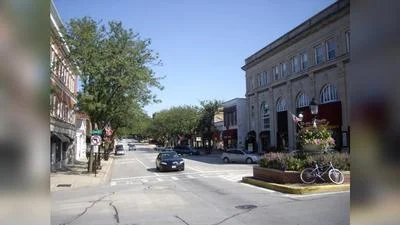Cook County Chief Judge Tim Evans is the key architect of the county’s infamous “bail reform” that has led to the parade of pretrial defendants released from detention but then charged with new crimes, and far fewer defendants showing up for court. Over 15,000-plus alleged crimes were committed by pretrial defendants freed under bail reform from late 2017 through mid-2022. 2,841 of them were classified as violent offenses, or “person offenses” such as battery, assault, or child neglect. Another 1,594 were weapons offenses. Those numbers are likely low, as my Wirepoints colleague Matt Rosenberg recently explained.
On Tuesday, Cook County voters rendered their verdict on Evans: Hurray!
He won his retention vote in a landslide:
 Source: Cook County.
Source: Cook County.
Evans has quite a history, actually, which is covered in Rosenberg’s recent book, What Next, Chicago?: Notes of a Pissed-Off Native Son.

(Cook County Chief Judge Tim Evans)
Evans started as an old school Chicago politico as an alderman in Richard J. Daley’s machine. He was an enthusiastic participant as far back as the 1970s in the city’s white-dominated system of patronage politics.
But he gradually changed to align with progressive winds blown in by Mayor Harold Washington,” Rosenberg wrote. “For Evans, bail reform represented a way to stay current as a progressive thought leader.”
Yes indeed. A progressive thought leader.
*Mark Glennon is founder of Wirepoints.
Inserted below are excerpts from Rosenberg’s book for those interested in Evans’ history
*********************
Evans draped himself in Washington’s mantle of envisioned reform but was also a creature of convenience. He’d been a top aide to a staunch Black loyalist of Daley’s Democratic Machine, the late 4th Ward Alderman Claude Holman, who in turn had been part of “Big Bill” Dawson’s Black Chicago machine. Dawson was a Black Republican Congressman who’d switched to the Democratic Party after President Franklin Roosevelt introduced sweeping social programs under his New Deal. Dawson controlled five crucial South Side wards, including Holman’s 4th Ward. Over time, the five Black wards grew to six.[i]
Holman’s loyalty, like that of the other so-called “Silent Six” Black aldermen back in the day, was to a white-run organization that gave high-ranking Blacks just enough patronage jobs to compensate for mandatory political work to ensure Democratic hegemony in the city’s elections.[ii] Holman once said with admirable Chicago-style candor at a city council meeting, “I am a puppet for Mayor Daley.” On his way up, Washington had played ball with the same crowd. The theory was, one had to. Evans, who’d earned a law degree, certainly did, and was clouted into suitable patronage jobs.
When Holman died in 1973, Evans had taken and then kept his seat as 4th Ward alderman. On the city council he was closely aligned with Daley, but was more congenial about it. Somewhat remarkably for a Black alderman in the ’60s and ’70s, Holman had been an attack dog against anti-Daley progressives.
Yet despite his start, a decade later Evans had managed somehow to recast himself. He was a high-profile Washington backer, and part of the city’s rising progressive conscience.[iii] Politics is like that. An old skin shed, a new one grown. Few even blink. And in the contest to win the special council vote following Washington’s death early in his second term as mayor, Evans backers portrayed Sawyer’s supporters as a shameful bunch. Some turncoat Black aldermen and the white aldermen who’d opposed Washington.
What followed was rich. At a memorial service for Washington attended by 11,000 people at the University of Illinois Circle Campus in Chicago (UIC), Vernon Jarrett put down a marker. The popular Black Chicago Sun-Times columnist was a fierce advocate for racial justice, as he conceived of it.
He told the crowd, “You have some Black people, who call themselves Black but who are Negroes, in the City Council who have ceased to be men and women. And you must deal with them not next week, not next month, not only in the next election, but tomorrow…do not let these fools drag us down with them back into chains. Take some action, whatever you think is necessary.”[iv]
On the night of the Sawyer-Evans showdown, thousands of demonstrators filled City Hall’s west side lobby and overflowed out into LaSalle Street. The protestors chanted, “Uncle Tom, Uncle Tom Sawyer.” Five of Sawyer’s council supporters had reported getting death threats since the UIC rally where Jarrett issued the call to arms. One alderman was wearing a bulletproof vest. Sawyer supporters were called by Evans backers “vultures” and “thieves.” Evans called Sawyer “a pretender to the throne.”[v]
The meeting lasted until 4 a.m. A trembling and equivocal Sawyer had the votes and became mayor. But his tenure was fairly brief because a special election was now required midway through what would have been Washington’s second term.
When that special election was held in 1989, memories of ugly political conflict between Blacks after Washington’s death helped swing white progressives and Latinos to Richard M. Daley, son of Richard J.
[i] Ciccone, 7
[ii] Ciccone, 5, 7
[iii] Anne Marie Lipinski, “Timothy Evans,” Chicago Tribune, March 3, 1989, https://www.chicagotribune.com/news/ct-xpm-1989-03-03-8903230965-story.html
[iv] Michael Miner, “Jarrett’s Agenda; Night of Infamy,” Chicago Reader, December 10, 1987, https://www.chicagoreader.com/chicago/jarretts-agenda-night-of-infamy/Content?oid=871512
[v] Bill Peterson, “In Pandemonium, Chicago Gets a Mayor,” Washington Post, December 3, 1987, https://www.washingtonpost.com/archive/politics/1987/12/03/in-pandemonium-chicago-gets-a-mayor/1b1625f7-6709-4805-a25b-96021f93f700/
What of Cook County Circuit Court Chief Judge Timothy Evans? As a Black Chicago alderman in the 1980s he’d sought and failed to claim Harold Washington’s progressive reform cloak as a mayoral contender after Washington’s 1987 death.
As Chief Judge, his office’s duties include overseeing court reporting, court interpreters, jury service, and more, in a system with about 400 judges and more than one million annual cases.[i]
But Evans’ influence has been greatest due to policy direction. Since 2017 he has championed and effectively enforced what’s called “bail reform.”
The central thrust of bail reform is letting pretrial arrestees out of jail before trial on no-cash or low-cash bail. Confined to first-time nonviolent offenders, it makes sense. But too often that’s not what has happened. Bail reform is now an inimical trend nationally.
We’ve already seen that Evans was an Old School Chicago politico and enthusiastic participant as far back as the 1970s in the city’s white-dominated system of patronage politics. And that he gradually shed that skin to align with progressive winds blown in by Washington. For him, bail reform represented a way to stay current as a progressive thought leader.
With equally vocal support from chief prosecutors in many of the nation’s biggest urban local court systems. including Philadelphia, New York, Los Angeles, and San Francisco, bail reform became a favored means of implementing social justice teachings and beliefs.
But it has run off the tracks nearly everywhere, including Cook County and Chicago, due to misuse. Suspects charged with violent crimes are let out on low-cash or no-cash bail and too often within months earn new charges for fresh violent crimes. Disturbingly often, those new charges include murder, shootings, or carjackings.
Here are just a few examples from 2020 of what’s happened in Chicago on the South and West Sides since Evans implemented bail reform in Cook County in 2017. We’ll hear more later.
● A five-time felon free on bond before trial on new weapons charges, killed two. One Chicagoan charged with murder in 2020 had five prior felony convictions with two for gun possession. In 2019, he was charged with possessing a firearm as a felon and for possession of a stolen firearm, before being set free on $500 bond and electronic monitoring.[ii] Then after an argument broke out during an outdoor party at his apartment building, he allegedly started shooting at guests. The thirty-nine-year alleged killer, Black, claimed two lives, also Black. Three more guests were hit with bullets.
● Repeat offenders free on bond before trial killed a retired firefighter. A carjacking crew of four young Black men allegedly killed a sixty-five-year-old retired Black Chicago firefighter as he fought their attempt to shoot him and take his car. All of the alleged shooters were eventually charged with murder. One had five juvenile convictions and four pending cases, including one for an alleged home invasion and kidnapping. Bail was no problem. Another shooter charged had three prior juvenile convictions for possession of a stolen vehicle, possession of a stolen gun, and carjacking. Just more than a month before the killing, he’d earned adult charges for stolen vehicle possession and aggravated unlawful use of a weapon. He’d been let free before trial.[iii]
● A serial carjacker free on bond before trial killed a young father. A sixteen-year-old Black youth who’d been freed on bond in three different juvenile cases for carjacking and stolen vehicle possession was charged as an adult for murder after he allegedly shot an Asian man in his thirties. He reportedly became frustrated when carjacking the man’s vehicle. Police said he couldn’t get it to start so he chased the victim into an alley, tried to rob him, and then shot him dead.[iv] The victim had a young child and now a shocked, grieving wife.[v]
For whom is compassion dispensed? Clearly not the victims in Chicago and Cook County.
Evans and his backers have continued to claim outcomes are no worse with bail reform than without. We’ll see later that claim has been difficult to defend.
[i] Circuit Court of Cook County, “Organization of the Circuit Court,” http://www.cookcountycourt.org/ABOUT-THE-COURT/Organization-of-the-Circuit-Court
[ii] CWB Chicago, “More Men Charged With Shooting People While Free On Bond,” September 14, 2020, https://cwbchicago.com/2020/09/more-men-charged-with-shooting-people-while-free-bail-for-gun-charges.html [iii] CWB Chicago, “Another Man, Free on Bail For Two Felonies, Charged With Killing Retired Fireman in Botched Carjacking,”
https://cwbchicago.com/2021/01/another-man-free-on-bail-for-two-felonies-charged-with-killing-retired-fireman-in-botched-carjacking.html
[iv] Megan Crepeau, “16-Year-Old Charged in Murder, Carjacking in Bridgeport Killing Caught On Video,” Chicago Tribune, January 14, 2021,” https://www.chicagotribune.com/news/breaking/ct-teen-bridgeport-murder-carjacking-charge-20210114-mbym2wjub5gq5gww264jpfviay-story.html
[v] Jermont Terry, ‘Widow Speaks After Husband Gave Up Jeep Cherokee, Only to be Shot Dead by Carjackers Anyway, in Bridgeport,” CBS2 Chicago, December 22, 2020, https://chicago.cbslocal.com/2020/12/22/only-on-2-widow-speaks-after-husband-gave-up-jeep-cherokee-only-to-be-shot-dead-by-carjackers-anyway-in-bridgeport
Back in Chicago and environs, and two years into bail reform in November 2019, Cook County Chief Judge Evans said to the county council of his bail reform program, “It’s not by magic we haven’t had any horrible incident occur using this new system.”[i]
Apparently Judge Evans did not count as “horrible” a score of 2019 murders and shootings in Cook County charged to suspects who’d been recently arrested on violent crime charges but then released by Cook County judges on no-cash or low-cash bond bail reform, rather than being detained until trial. In these instances, a man was fatally shot in the back of his head; a fifteen-year-old girl wounded in a drive-by; a man murdered sitting in his car; and a murder attempted.[ii]
I’ve outlined the case of Sincere Williams in Chapter Two, who robbed a gun shop, was set free, and then charged with killing Walgreen’s clerk Olga Calderon. But there’s more. Williams never should have been released after the attempted robbery in Melrose Park, said the gun shop owner. “It enraged me that a woman is now dead, and all they had to do was keep this guy in custody. Obviously, it could have been prevented. He was in custody in May. I’m appalled that’s how our system works.”[iii]
Calderon’s fiancé Israel Alvarado said she left behind an eleven-year-old daughter and a three-year-old son. Alvarado added, “This event has shattered our families. Left children without a mother…Left me without the most important person in my life…This could have been prevented if people cared. If people weren’t so involved in their own agendas…. She was a good person.”[iv]
Likewise, I alluded briefly to the case of Chicagoan Timmy Jordan, who had five prior felony convictions—including two for gun possession—and was charged in 2019 for possessing a firearm as a felon and for possession of a stolen firearm before being released on a $500 bond.[v] I’ve noted he later allegedly shot dead two guests and wounded three after an argument broke out during a party he was at.
What I haven’t shared yet is the police reaction and the human impact. The two killed were Michael Mickey, thirty-five, and his aunt Lunyea Wilson, forty-seven.
Chicago Police Chief David Brown was livid that Jordan had been earlier released by Cook County courts on low cash bond. He said Jordan’s prior record of felony convictions and gun offenses was reason enough to have made sure he was kept behind bars while awaiting trial on his latest charge. He said, “What are we doing? I mean, it’s beyond frustrating. It makes your blood boil….”[vi]
A Facebook post[vii] about the tragedy drew nearly 2,000 shares. One commenter wrote, “Can’t believe this. Michael Mickey was a wonderful guy. He trained me when I used to work for Dunbar armored vehicles, now it’s owned by Brinks but he was a crew chief for Dunbar. I mean this is shocking for me. An honest hardworking guy who was never in any trouble. We used to sing in the armored truck driving to do our deliveries.”
Another wrote, “He was so sweet and nice. Always talking about his family and God and all the things he wanted to do. Man, so sad.” Poppie K. Yatta wrote, “This man was like my blood, great guy, sweet heart, hard worker, great friend, great family member, comedian, problem solver.”
December Pitts wrote: “Everyday all day!!! Not one single day goes by without a killing here.”
Corey Hilliard: “Westside somethin’ else.”
A piercing arrow came from Shoni Johnson, grieving Lunyea Wilson and Michael Mickey: “This was my kids’ father’s sister and family. Chicago is taking everybody. Exactly why I left. I pray for Chicago.”
No, Chief Judge Evans. Not any “horrible incidents” here, tying back to bail reform.
Matt Walberg is a spokesman for Cook County Sheriff Tom Dart. He said electronic monitoring “should be reserved for those facing low-level, non-violent crimes. The purpose of electronic monitoring was never to replace pretrial detention for violent offenders but to reduce overcrowding by releasing individuals who pose no risk to their communities to home supervision.”[viii]
In November 2020, Sheriff Dart told the Cook County Board that the electronic monitoring regime accompanying Evans’ bail reform program instituted in 2017 is overwhelmed, because there are so many defendants who are released before trial and so few dedicated officers to track their whereabouts when they violate home detention rules.
Dart said, “We didn’t get extra money, didn’t get extra resources, didn’t get anything. On an average day, we have about twenty people out for the entire county, per shift, to watch 3,300 people.”[ix]
In December 2020, the same type of court-sanctioned disregard for human life that claimed Olga Calderon, Michael Mickey, and Lunyea Wilson took a pillar of Chicago’s Black community.
I’ve already mentioned the retired firefighter, age sixty-five, slain by shooters in a four-man carjacking crew. And that two of the suspects charged for murder had been beneficiaries of light sentencing and light bail.
The victim’s name was Dwain Williams. You should know more about him. A father of four daughters, Williams had worked for the Chicago Fire Department for more than twenty-five years and at the city’s Office of Emergency Management and Communications, where he’d helped coordinate the city’s network of surveillance cameras. In the Black Fire Brigade, he coached teens toward careers as paramedics and firefighters.[x] He was also an accomplished musician who played in a band with other firefighters.
Williams had been a regular customer of the Let’s Get Poppin popcorn shop for twenty-five years. He stopped in usually twice weekly to buy snacks and chat with the workers.
Chicago Alderman Jason Ervin of the 28th Ward said, “To see a strong African-American man who has been a provider for his family, working with the community, working with our youth, and trying to develop other young strong Black men—to see him gunned down in the streets of our city was just atrocious.”[xi]
Semaj Dixon in early 2021 was age twenty-one and a felon with seven convictions. He’d been released on $500 bond in October 2020 by a Cook County judge after being charged as a Class X felony armed habitual criminal and for unlawful possession of a firearm by a felon, criminal trespass to vehicle, and having a high-capacity magazine. One more “non-violent” criminal who’d merely run afoul of the technical requirements of gun laws.
In April 2021, while still wearing his ankle bracelet, Dixon and his brother allegedly chased down Eugene Broach, also twenty-one, who lived on the same South Side Chicago block as them in Roseland. As Broach lay crouched in a fetal position on the street, prosecutors said the two fired a total of eighteen shots at him. Eleven bullets hit Broach. He died. Dixon was finally ordered held without bond, for murder.[xii]
Publicly nobody breathed a word about Eugene Broach beyond initial reports of the shooting. He was just another number. Another forgettable young Black man gunned down in Chicago. A Black life that didn’t matter. Cops hadn’t shot him. There were no angry protests in front of the Cook County courts facility on the West Side for the taking of Eugene Broach’s life.
I’m still hearing the voice of Cook County Chief Judge Timothy Evans talking to the Cook County Council about bail reform. “It’s not by magic we haven’t had any horrible incidents occur using this new system.”
In 2020, Chief Judge Evans had released a report claiming there was no increase in Chicago crime after bail reform was enacted. Only 147 felony defendants released before trial on low cash or no-cash bail within a year and a quarter had been charged with new felony offenses, the report claimed.
Except it was actually at least four times that number, according to an analysis the Chicago Tribune was able to complete only after winning a special public records appeal before the Illinois Supreme Court. The data the paper needed had initially been withheld. It became clear why.
The Trib reported that Evans’ office had cooked the numbers by failing to count at least six different categories of felony crimes as felonies. These were assault, assault with a deadly weapon, armed violence, reckless homicide, battery, and domestic battery. These apparently didn’t rise to Chief Judge Evans’ threshold of “horrible.” The bail reform subjects charged with new crimes were also undercounted because they didn’t include misdemeanor arrestees later charged with felonies.[xiii]
There’s also a huge X factor making it worse. No one knows how much crime is perpetrated by arrestees out on low-cash or no-cash bail — or by previously convicted felons who’ve been lightly sentenced—because so many crimes aren’t reported. That’s exceedingly common in Chicago because of retribution fears. Nationally, an estimated 59 percent of the violent victimizations of people, not including murder, remained unreported in 2020.[xiv]
But with leadership—if that is the word—from the Illinois House Black Caucus, the Democratic-controlled state legislature in February 2021 approved a police reform law that among other things, eliminates cash bail by 2023. It was signed into law by Democratic Governor J. B. Pritzker. There was leeway to hold dangerous offenders without bail.[xv] But Cook County judges in 2021 were clearly ignoring what constitutes a risky release.
[i] David Jackson, Todd Lighty and Gary Marx, “Bail Reform Analysis by Cook County Chief Judge Based on Flawed Data, Undercounts New Murder Charges,” Chicago Tribune, February 13, 2020, https://www.chicagotribune.com/investigations/ct-cook-county-bail-bond-reform-tim-evans-20200213-tkodxevlyvcp7k66q2v2ahboi4-story.html
[ii] CWB Chicago, “Chief Judge Says There Have Been No ‘Horrible Incidents” Under His Affordable Bail Program. These People Might Disagree, if Only They Were Still Alive,” November 21, 2019, https://cwbchicago.com/2019/11/chief-judge-says-there-have-been-no-horrible-incidents-under-his-affordable-bail-program-these-people-might-disagree-if-they-only-they-were-still-alive.html
[iii] Charlie De Mar, “Melrose Park Gun Shop Owner Says Sincere Williams Burglarized His Store Months Ago, Should Not Have Been On Street When Walgreens Murder Happened,” CBS2 Chicago, September 11, 2020, https://chicago.cbslocal.com/2020/09/11/melrose-park-gun-shop-owner-says-sincere-williams-burglarized-his-store-months-ago-should-not-have-been-on-street-when-walgreens-murder-happened/
[iv] Hannah Alani, “Fiance of Olga Calderon, Slain Wicker Park Walgreens Worker, Speaks Out: ‘This Event Has Shattered Our Families,’” Block Club Chicago, September 16, 2020, https://blockclubchicago.org/2020/09/16/fiance-of-olga-calderon-wicker-park-walgreens-employee-speaks-out-this-event-has-shattered-our-families/
[v] CWB Chicago, “More Men Charged with Shooting People While Free Bail for Gun Charges,” September 14, 2020, https://cwbchicago.com/2020/09/more-men-charged-with-shooting-people-while-free-bail-for-gun-charges.html
[vi] CBS2 Chicago, “Timmy Jordan, 39, Charged with Murder in Mass Shooting at West Side Party,” September 15, 2020, https://chicago.cbslocal.com/2020/09/15/timmy-jordan-39-charged-with-murder-in-mass-shooting-at-west-side-party/
[vii] Legal Help Firm post on Facebook, “Aunt and Nephew Killed,” September 12, 2020, https://www.facebook.com/lhfirm/posts/765664904006279
[viii] Frank Main, “As Murders Soar in Chicago, Judges are Freeing More Violent-Crime Suspects on Electronic Monitoring,” Chicago Sun-Times, August 21, 2020, https://chicago.suntimes.com/2020/8/21/21373707/electronic-monitoring-violent-crime-cook-county-chicago-police-department-david-brown-kim-foxx
[ix] Paige Fry, Jessica Villagomez and Megan Crepeau, “Cook County Murder Defendant Who Fled to Ohio One of More than 50 Murder Defendants Here out on Bond and on Electronic Monitoring,” Chicago Tribune, November 9, 2020, https://www.chicagotribune.com/news/criminal-justice/ct-electronic-monitoring-murder-escape-20201109-lrkup6jsprdfposn3nepimoz5m-story.html
[x] Vi Nguyen, “15-Year-Old Charged With Murder in Killing of Retired Fire Lieutenant: Prosecutors,” NBC5 Chicago, December 17, 2020 https://www.nbcchicago.com/news/local/15-year-old-charged-with-murder-in-killing-of-retired-fire-lieutenant-police/
[xi] CBS2 Chicago, “City Council Honors ‘Great Hero’ Dwain Wiliams, Retired Firefighter Killed in Attempted Carjacking,” January 27, 2021, https://chicago.cbslocal.com/2021/01/27/city-council-honors-great-hero-dwain-williams-retired-firefighter-killed-in-attempted-carjacking/
[xii] CWB Chicago, “#16: Man Chased Down and Killed Victim While on Electronic Monitoring for Gun Case, Prosecutors Say,” April 18, 2021, https://cwbchicago.com/2021/04/16-man-chased-down-and-killed-victim-while-on-electronic-monitoring-for-gun-case-prosecutors-say.html
[xiii] Jackson, Lighty, and Marx, Chicago Tribune, February 13, 2020
[xiv] Rachel E. Morgan and Jennifer L. Truman, “Criminal Victimization, 2019,” U.S. Department of Justice, Office of Justice Programs, Bureau of Justice Statistics, September 2020, https://bjs.ojp.gov/content/pub/pdf/cv19.pdf
[xv] NBC5 Chicago, “Illinois Becomes First State to Commit to Eliminating Cash Bail,” February 22, 2021, https://www.nbcchicago.com/news/local/illinois-becomes-first-state-to-eliminate-cash-bail/2444424/





 Alerts Sign-up
Alerts Sign-up